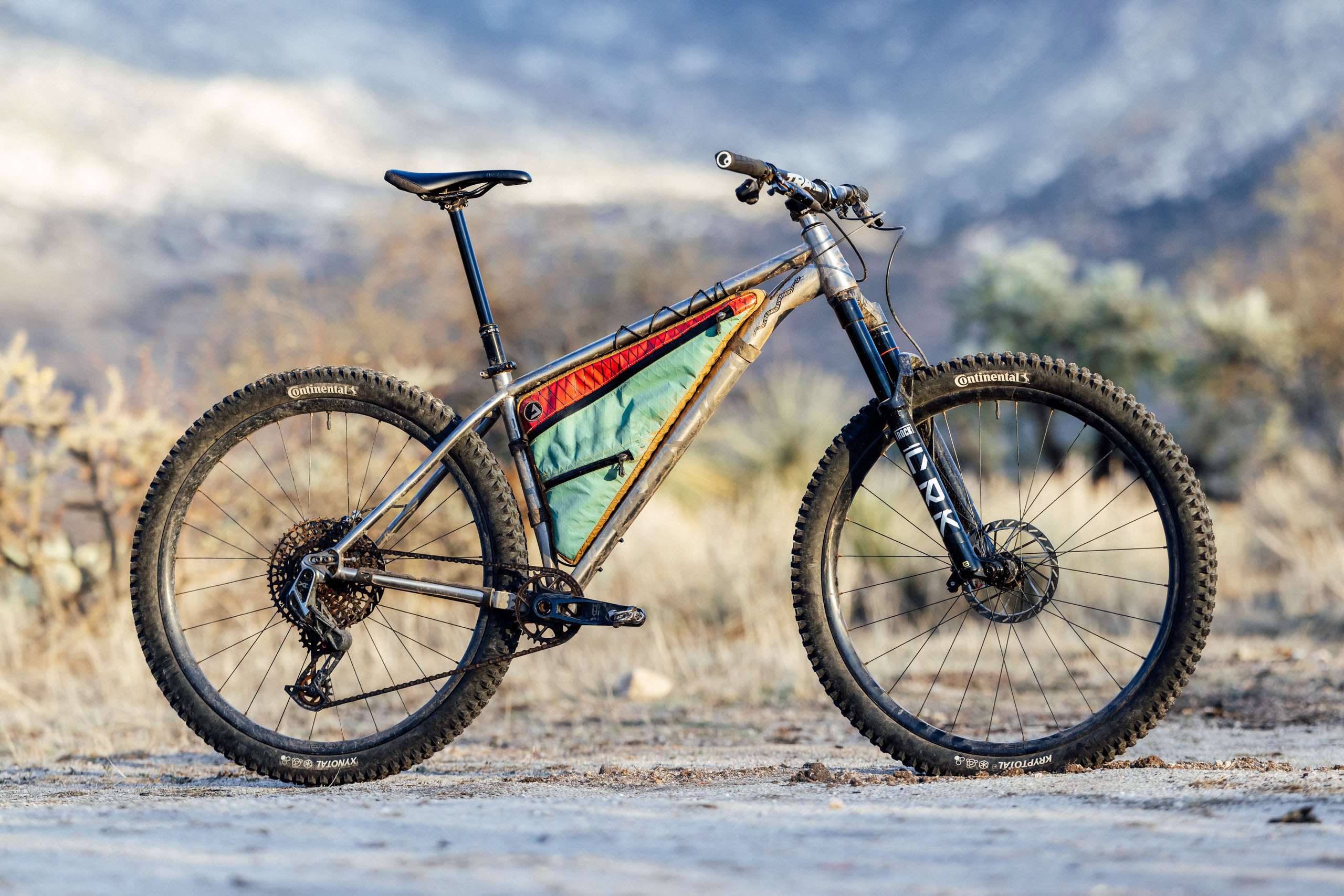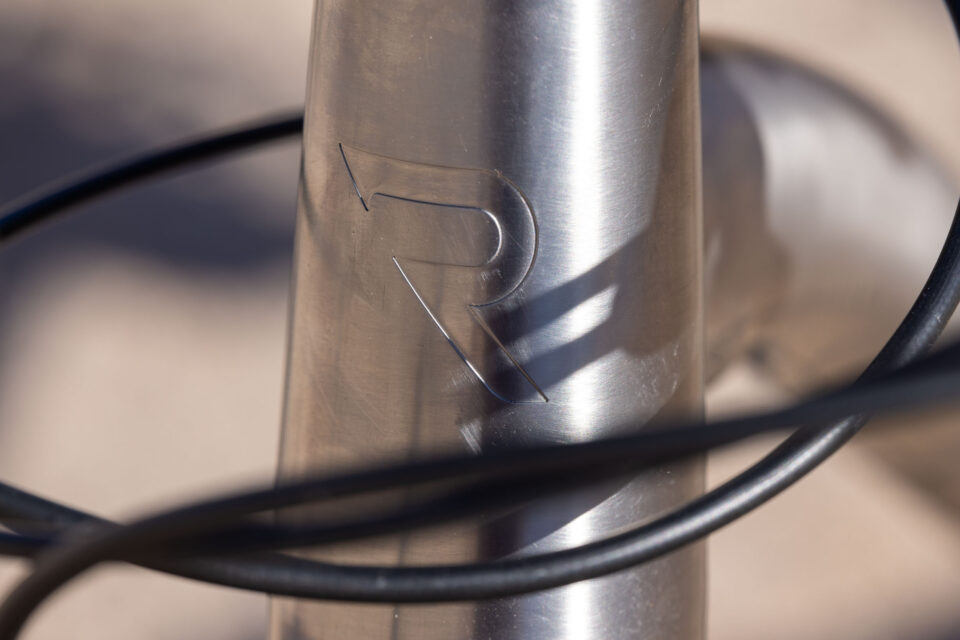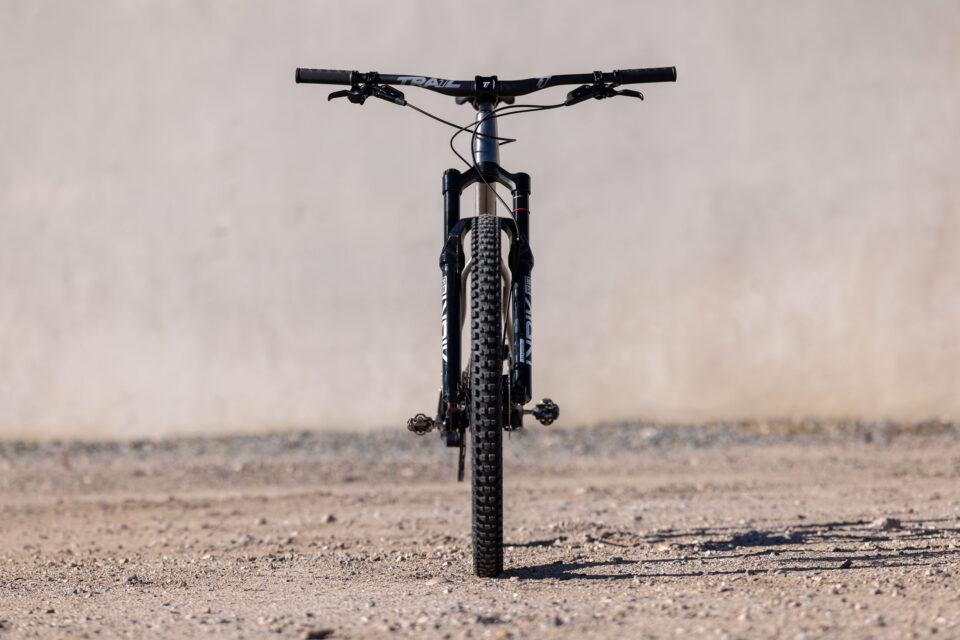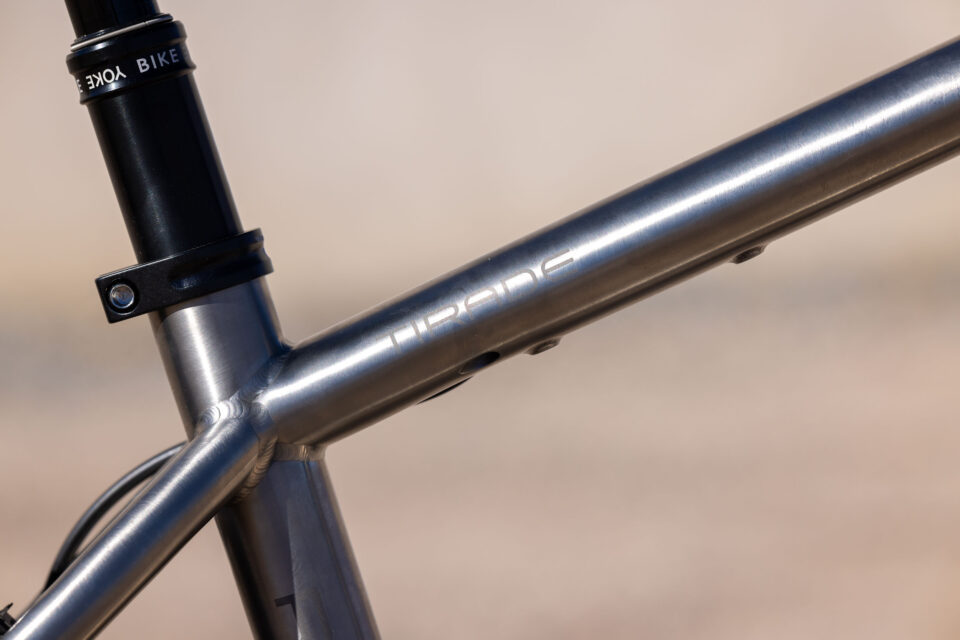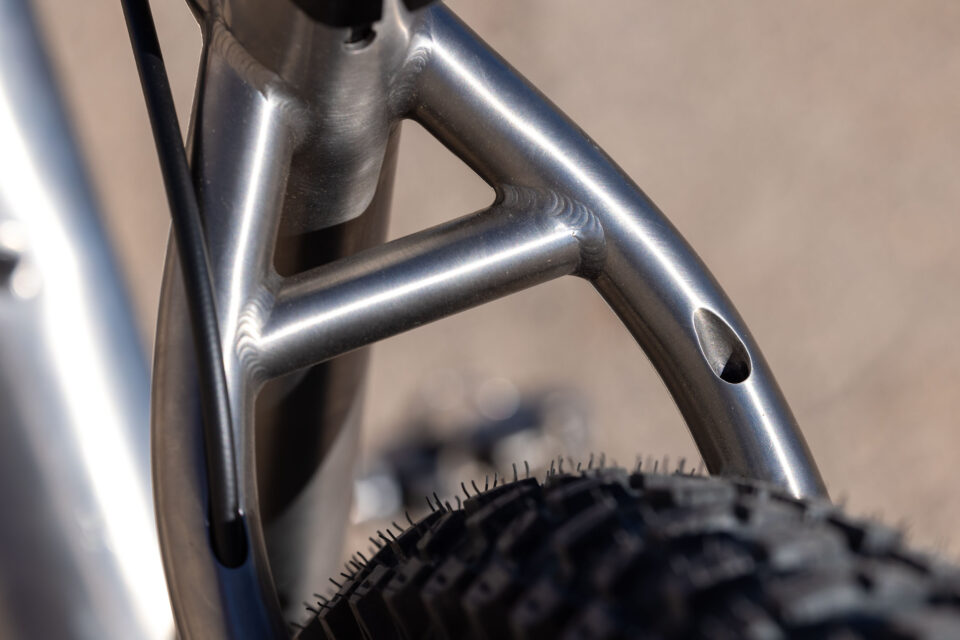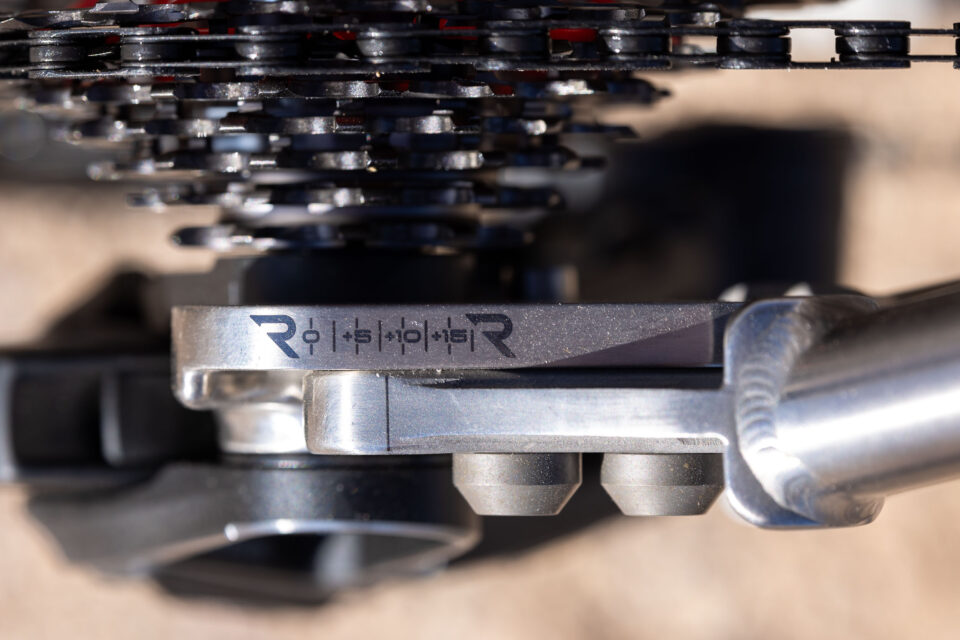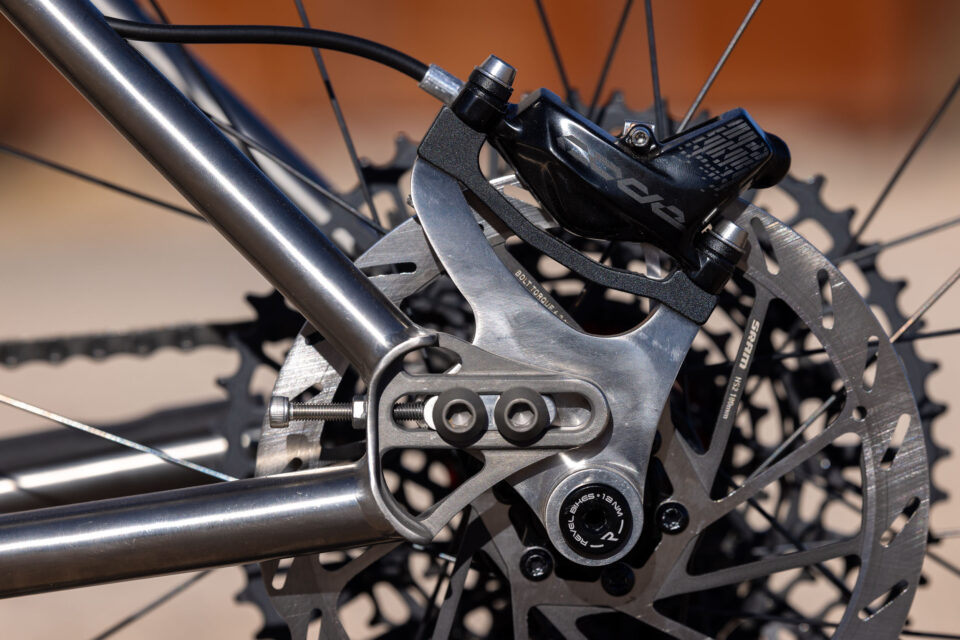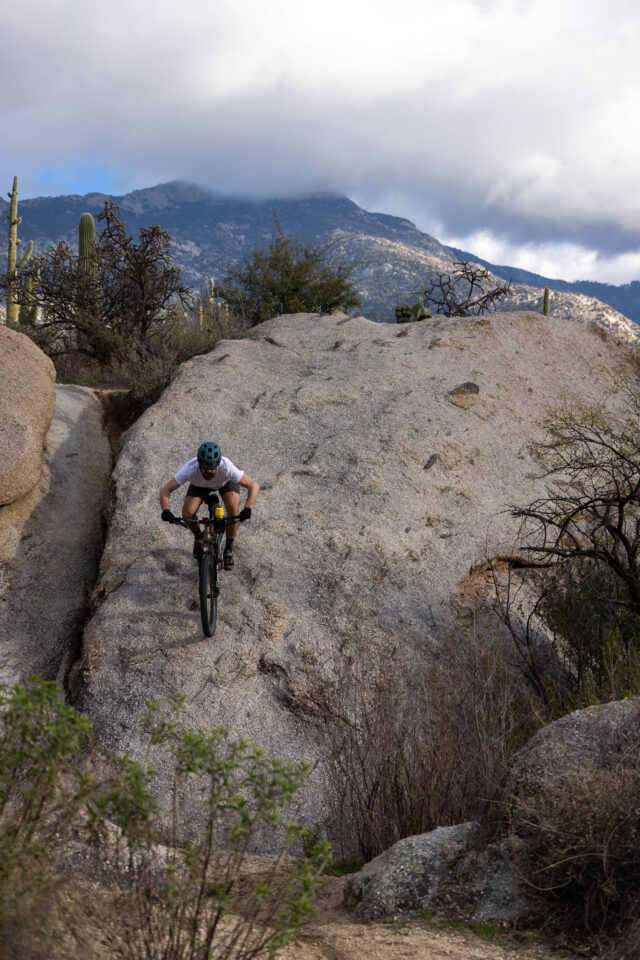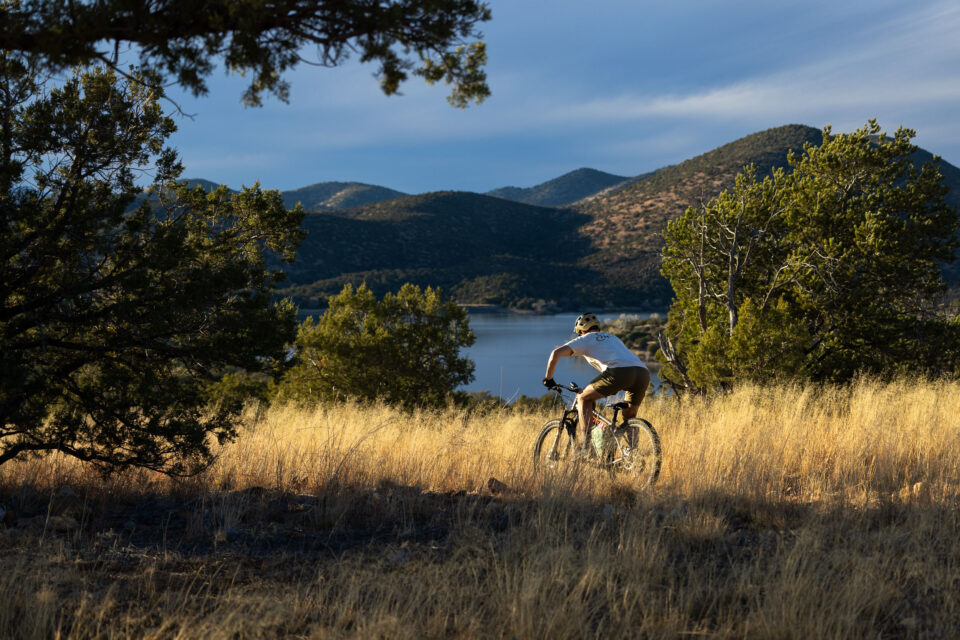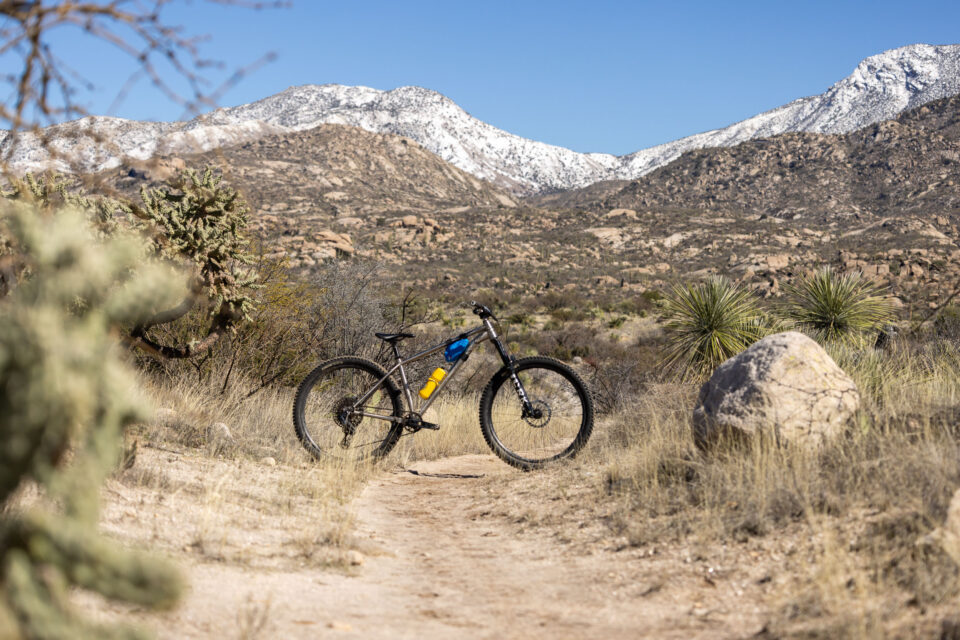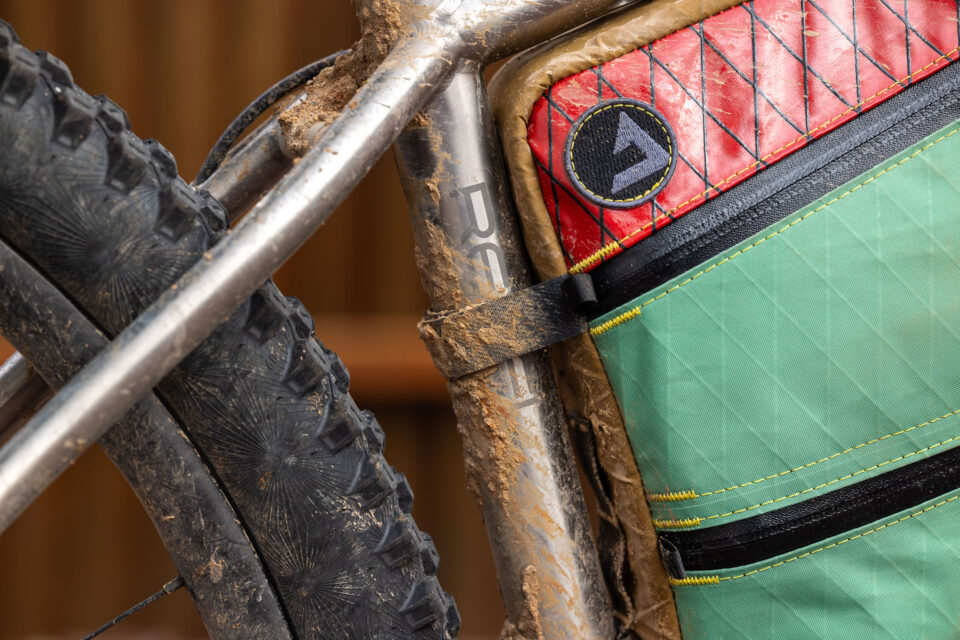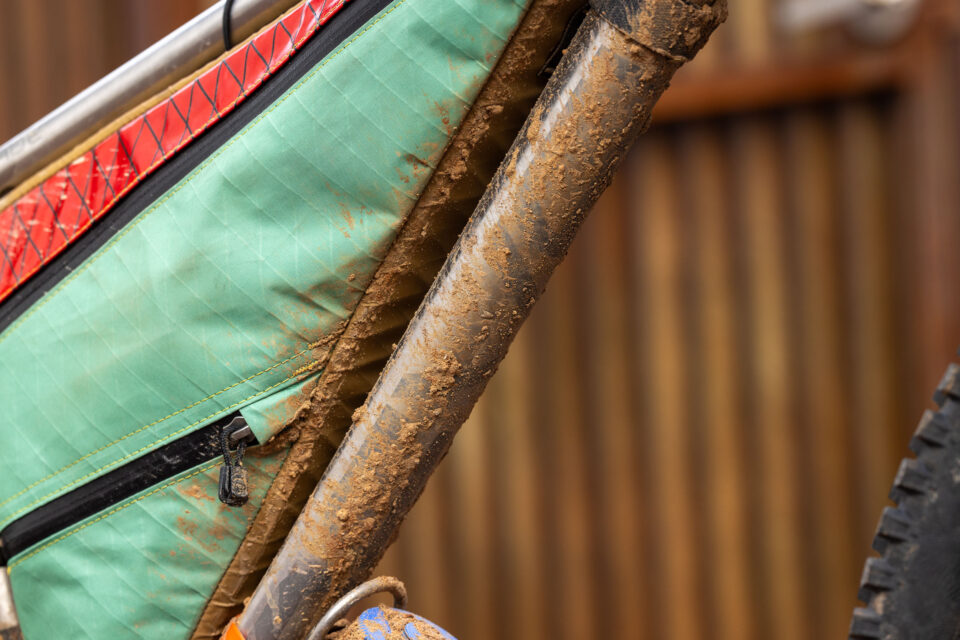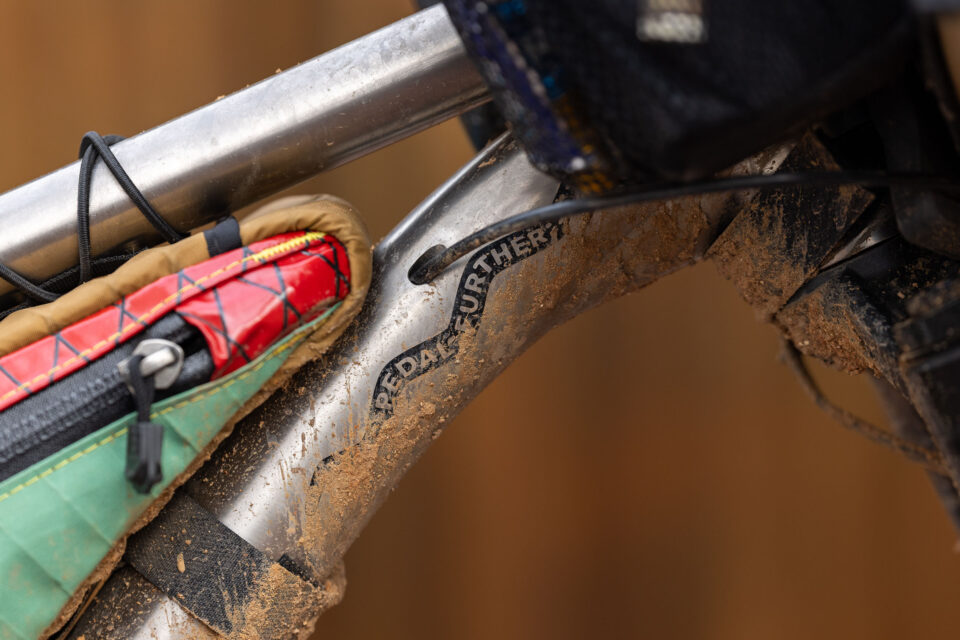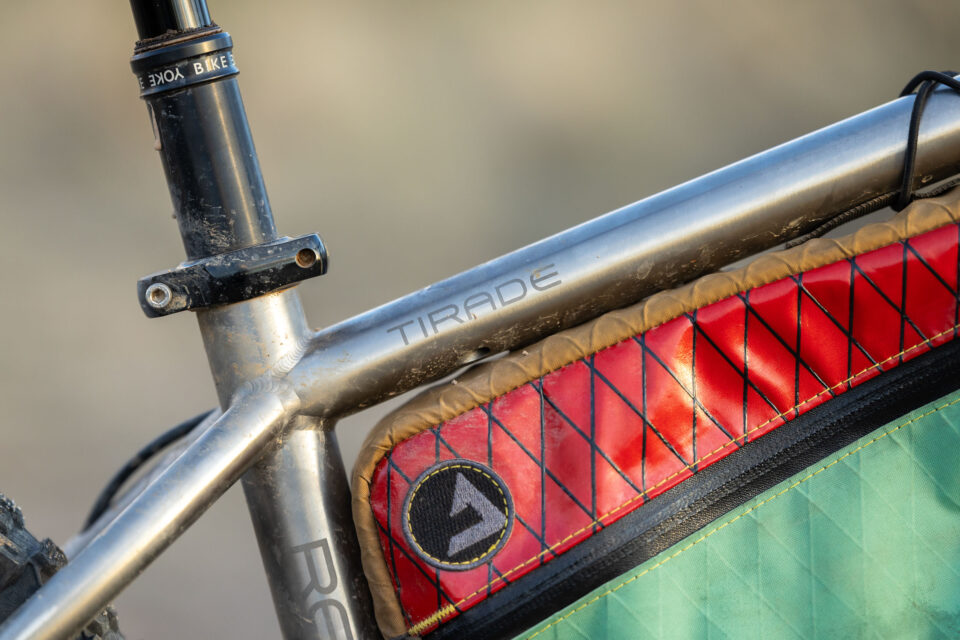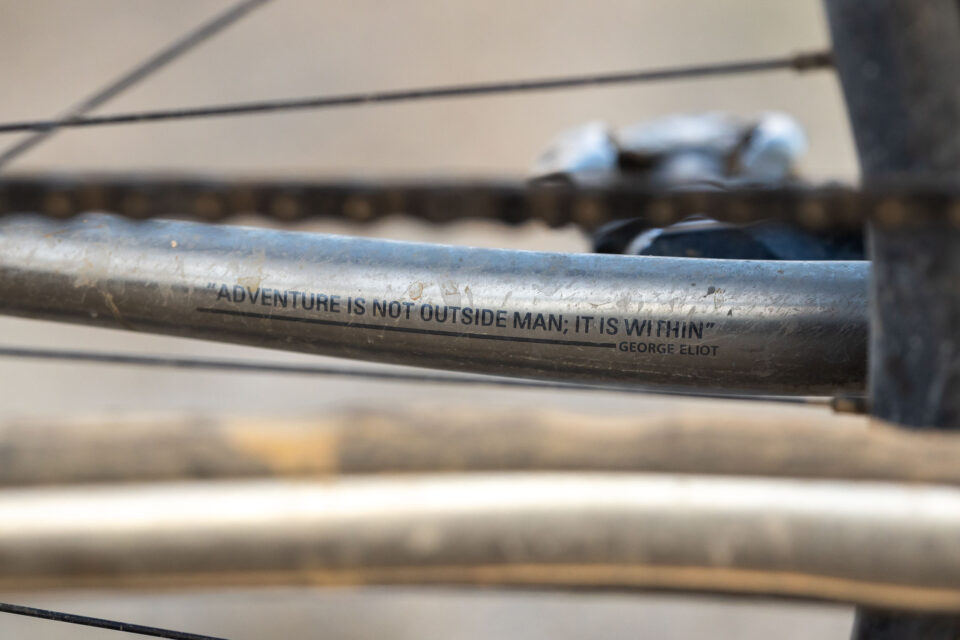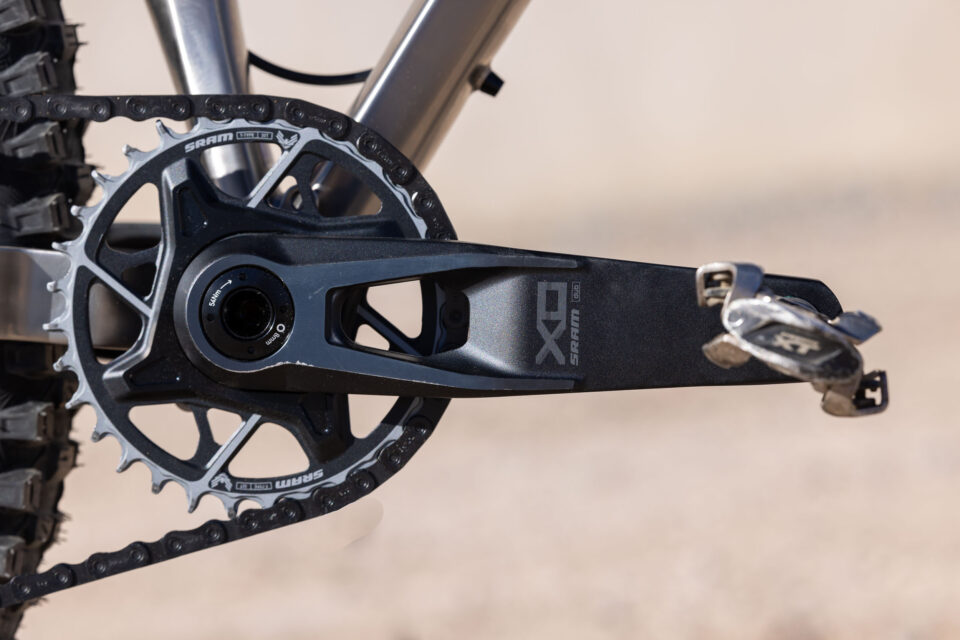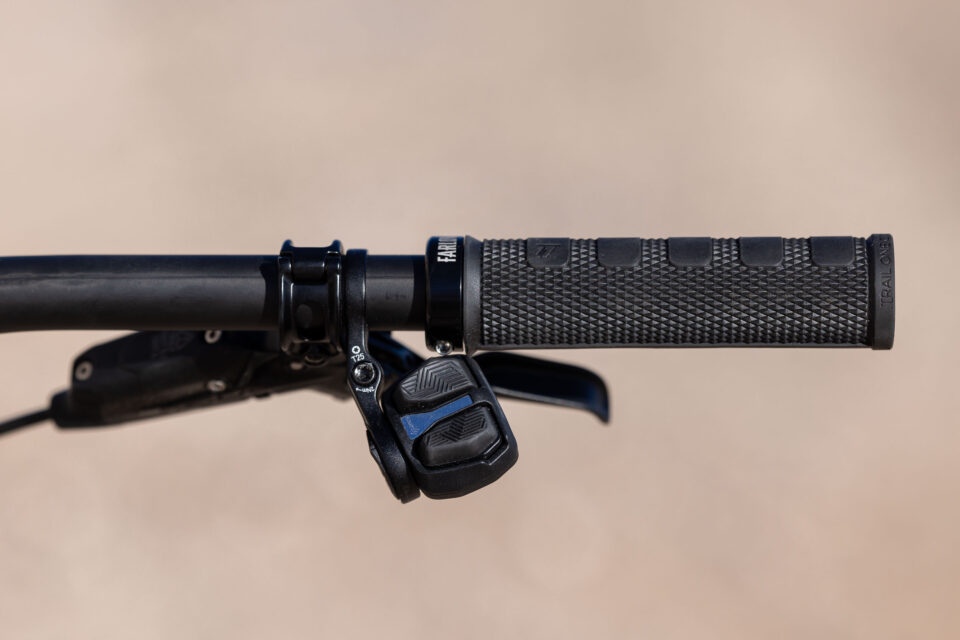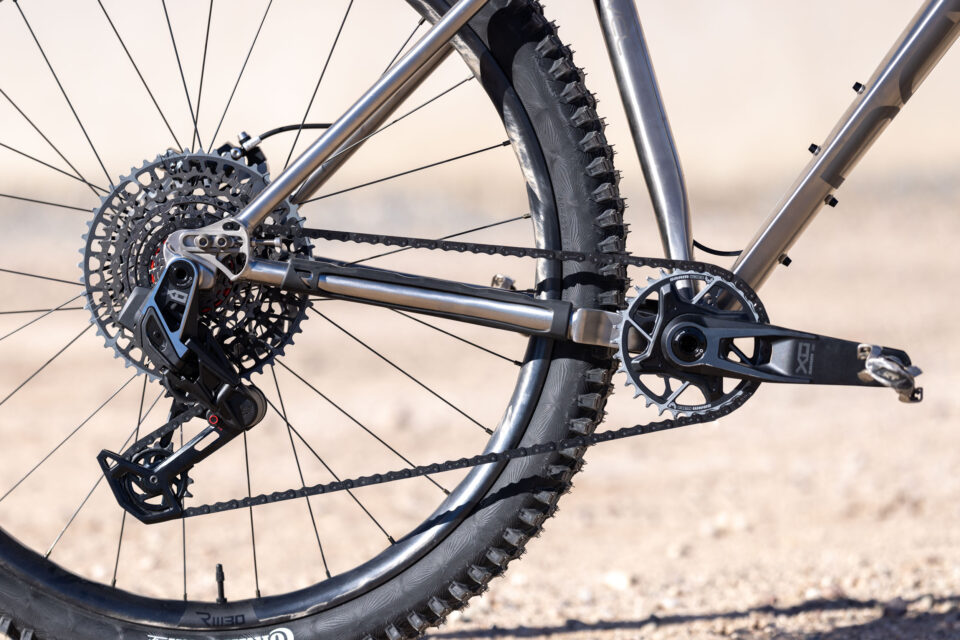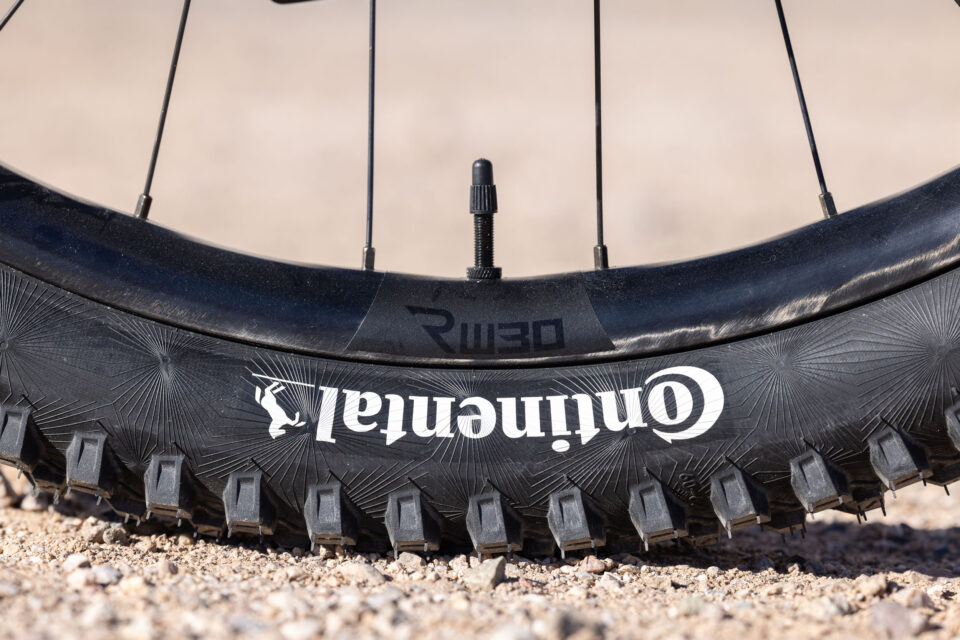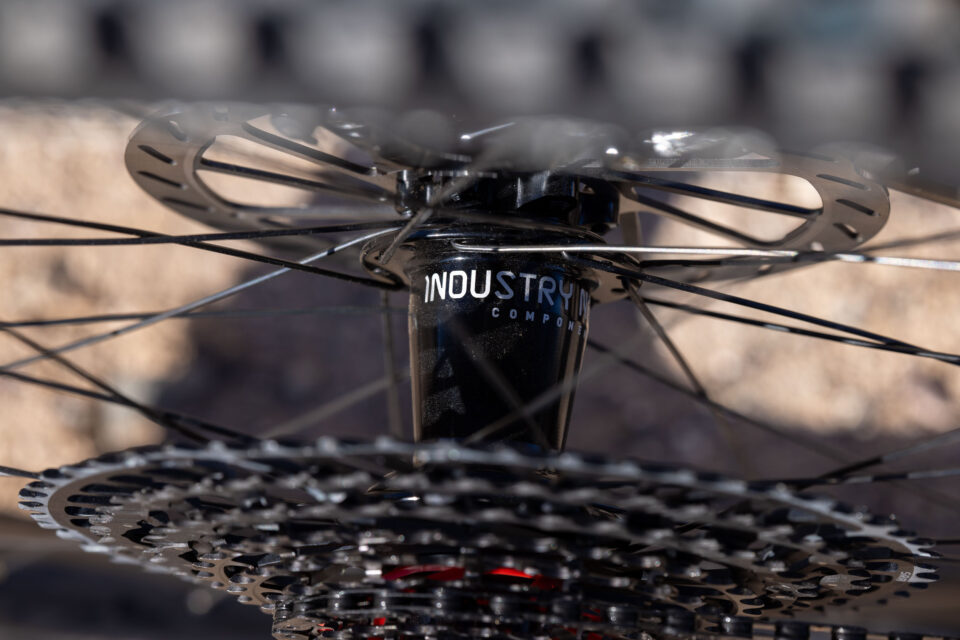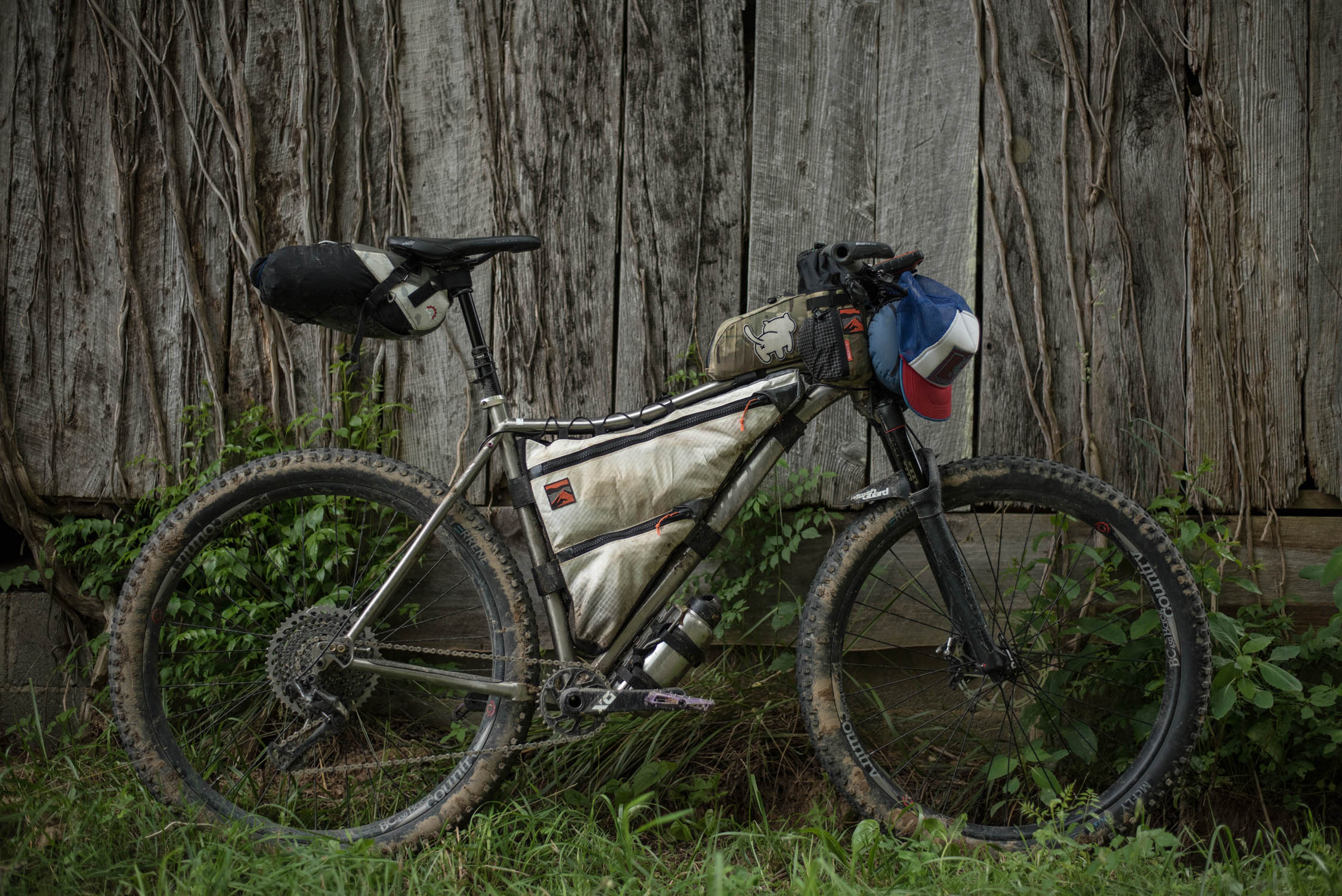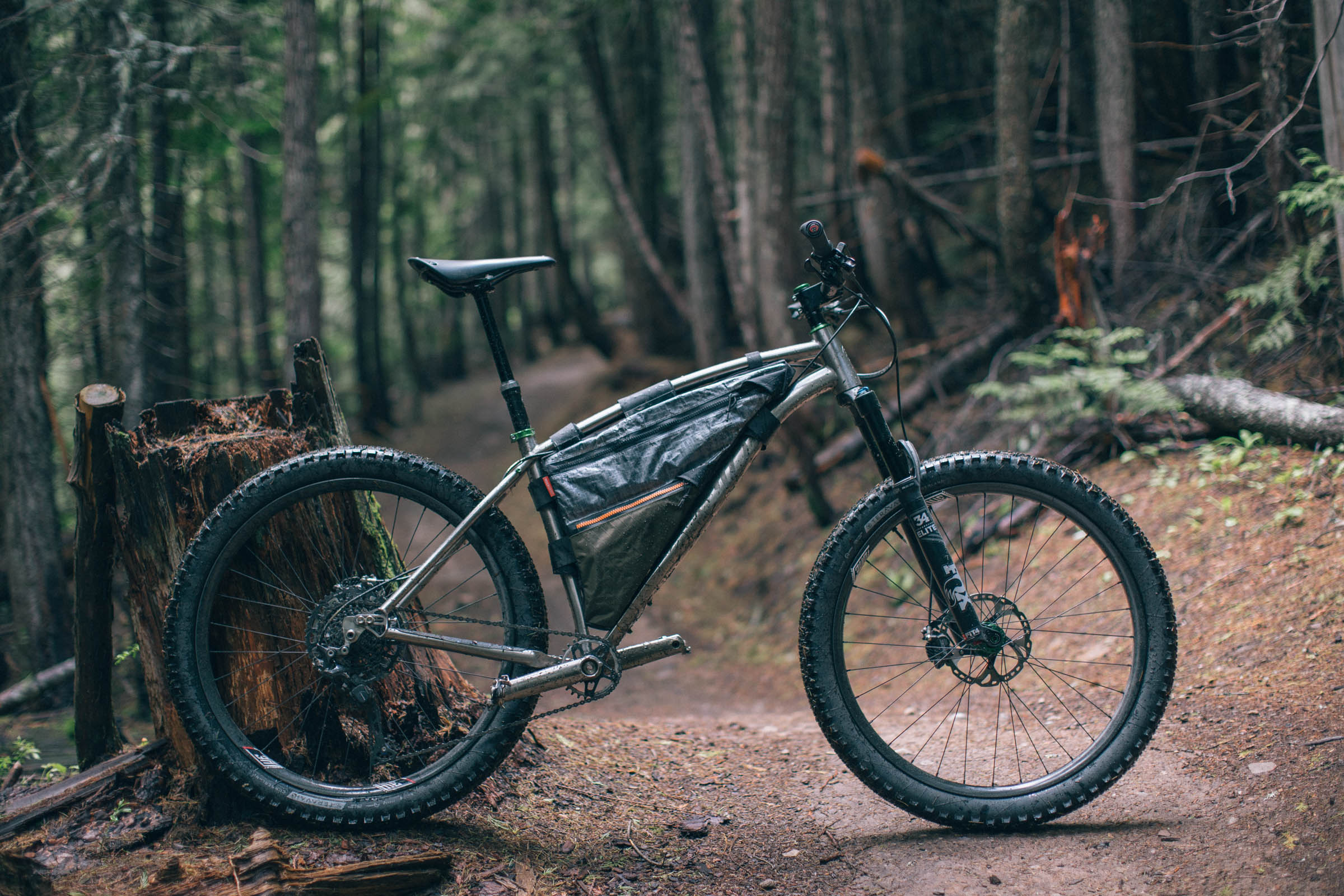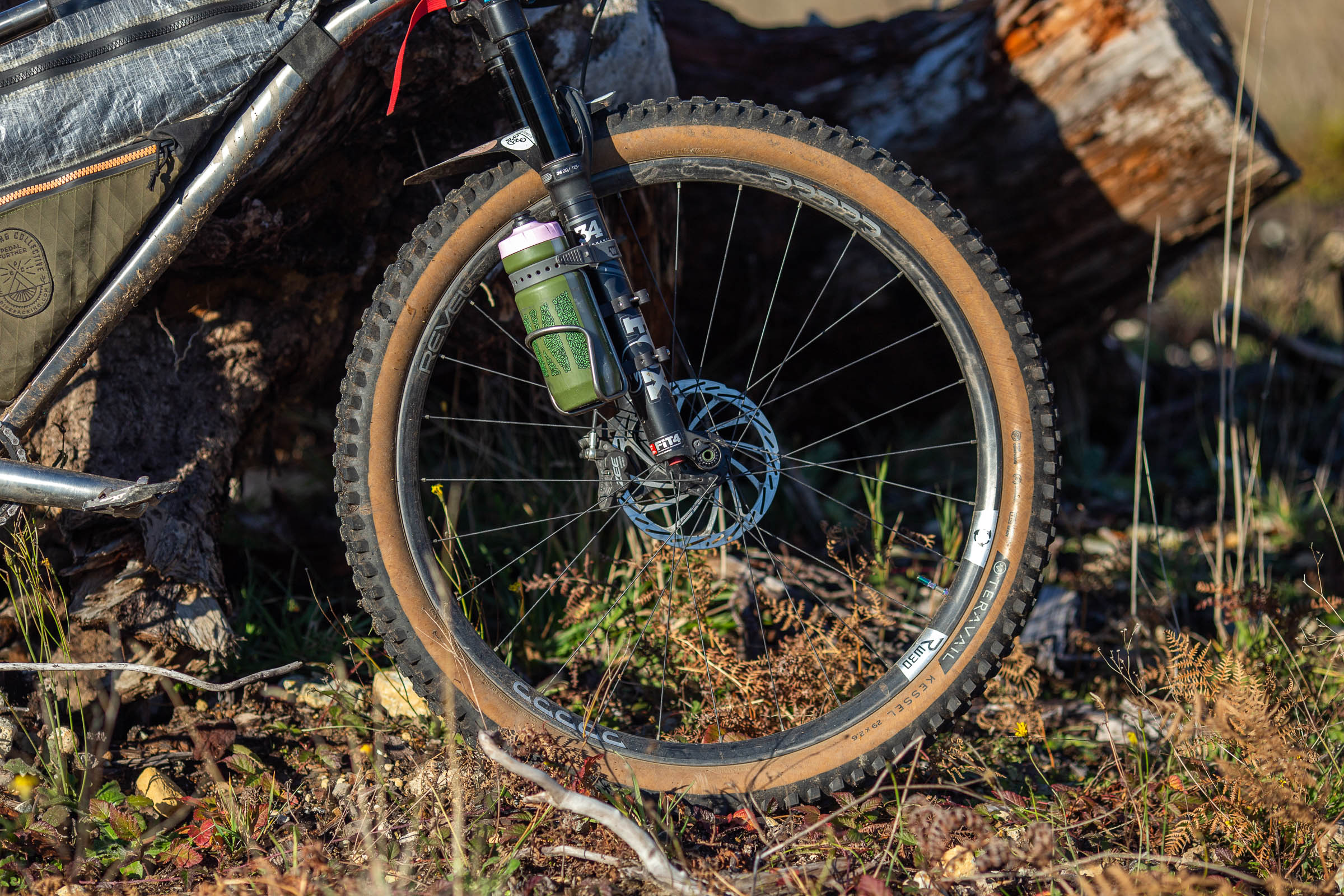Revel Tirade Review: Arizona Trail Approved
Share This
Designed around a thoughtful titanium frame and a 140-150mm travel fork, the Revel Tirade is the Colorado-based brand’s heaviest-hitting hardtail yet. We were curious to see how it compares to the now-defunct Why S7 and what it offers as a mid-travel bikepacking rig. Coinciding with today’s launch, Miles has been pedaling around Southern Arizona for several weeks to find out. Dig into our full Revel Tirade Review here…
Additional riding photos by Neil Beltchenko and John Montesi
It’s no secret that bicycle geometry has evolved rapidly over the last decade. What was considered slack and aggressive 10 years ago has been replaced with—I hate to say it—longer, lower, and even slacker geometry. We have more options than ever when it comes to hardtail mountain bikes. There are racey cross-country bikes for shaving time off your local riding loop, do-everything trail bikes that climb just as well as they descend, all-terrain bicycles somewhere in the middle, and the latest breed of ultra-rowdy, enduro-inspired bikes that many bikepackers would have cautiously avoided not long ago.
While geometry goes in and out of style, frame material does not. The reasons for choosing titanium or steel over carbon and aluminum have maintained some consistency in our corner of the bicycle community. This could be its own article, but titanium offers what’s arguably the highest strength-to-weight ratio. It’s extremely rust and corrosion-resistant even when left raw, and it offers excellent vibration dampening and the potential for a finely tuned ride quality when done right. Not all titanium frames are created equal, though, and the highest-quality frames use top-shelf tubing and time-intensive shaping processes to get the most out of the material. This begs the question: is there such a thing as the perfect blend of geometry, construction, and components?
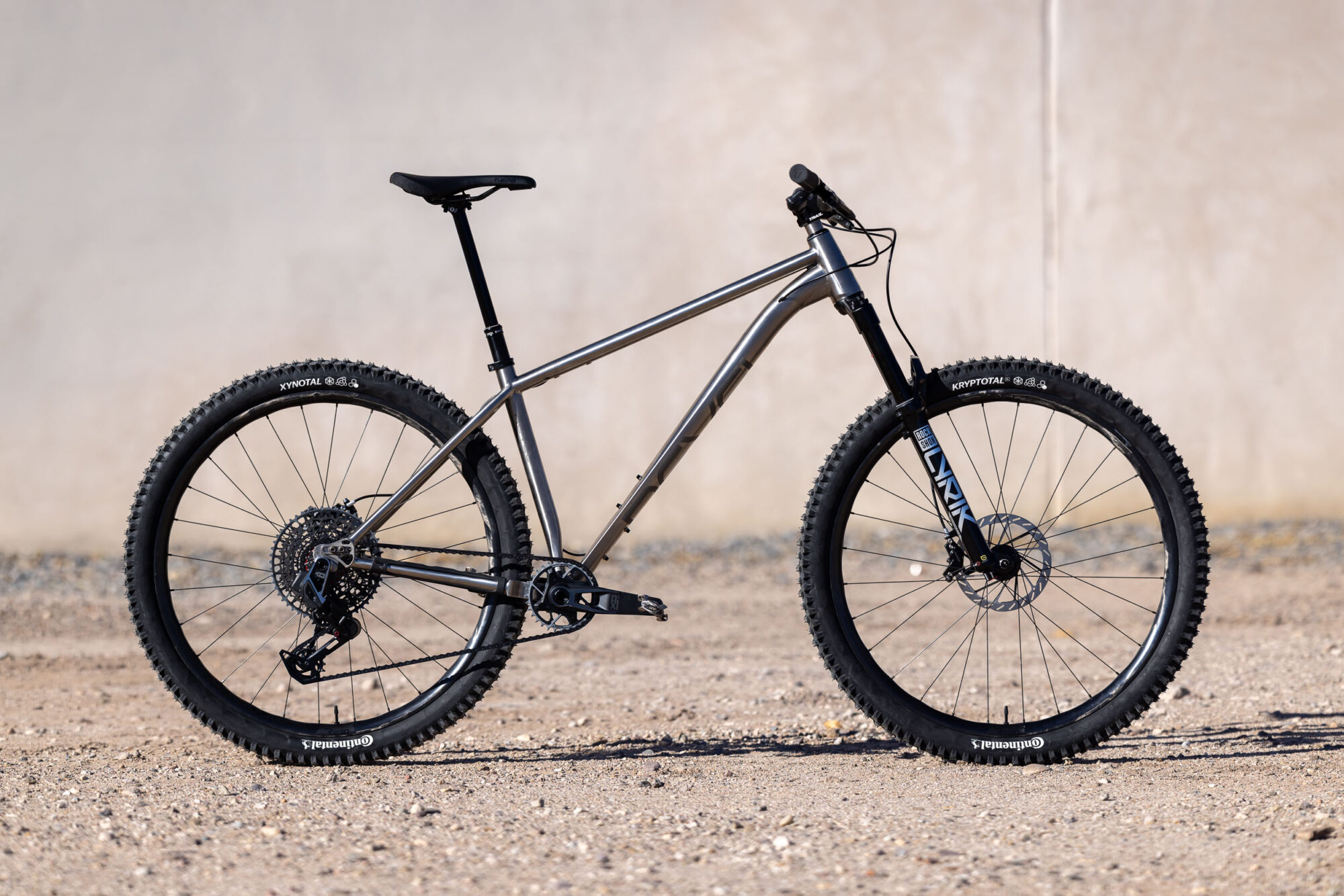
Revel, formerly Why Cycles, has worked with Ti for nearly a decade. They’ve always prided themselves on using the highest grade titanium, surpassing ISO standards, and standing behind their lifetime warranty. They’ve also developed a reputation for catering to bikepackers, stewarding several titanium bikes that have become classic choices for folks looking to ride away on far-off adventures. I’ve followed their evolution and couldn’t help but notice they’ve pushed the pause button on a specific genre of hardtail mountain bike. My beloved Why S7 has felt slightly outdated compared to the latest crop of shreddy hardtails, the Revel El Jefe felt a touch too sporty for my liking, and the Wayward isn’t quite the tool for trail riding in the Pacific Northwest. Thankfully, the folks at Revel share a similar sentiment and are filling in the gap with their latest titanium offering: the Revel Tirade.
The Why/Revel Ecosystem
To fully understand where the Revel Tirade fits into their current lineup, it’s worth taking a trip down memory lane. Revel, formerly Why Cycles, began writing their titanium hardtail story in 2016 with the S7, which was their flagship bike. The S7 was a unique, playful 27.5+ trail bike with a slack (at the time) head tube angle, short chainstays, and a low bottom bracket. The Why Wayward joined a year later, positioned as a 29+ multi-day adventure bike with a steeper head tube and longer chainstays for an even more planted ride. The lineup expanded again in 2021 with the addition of the El Jefe, complementing its older siblings as a “more racey, go-fast bike,” as Jefe Branham, the person it’s named after, told us. At the time of the El Jefe’s release, we wondered if it was a replacement for the S7. After all, they shared similar geometry and features, but the El Jefe looked like a more modern 29″ version of the S7.
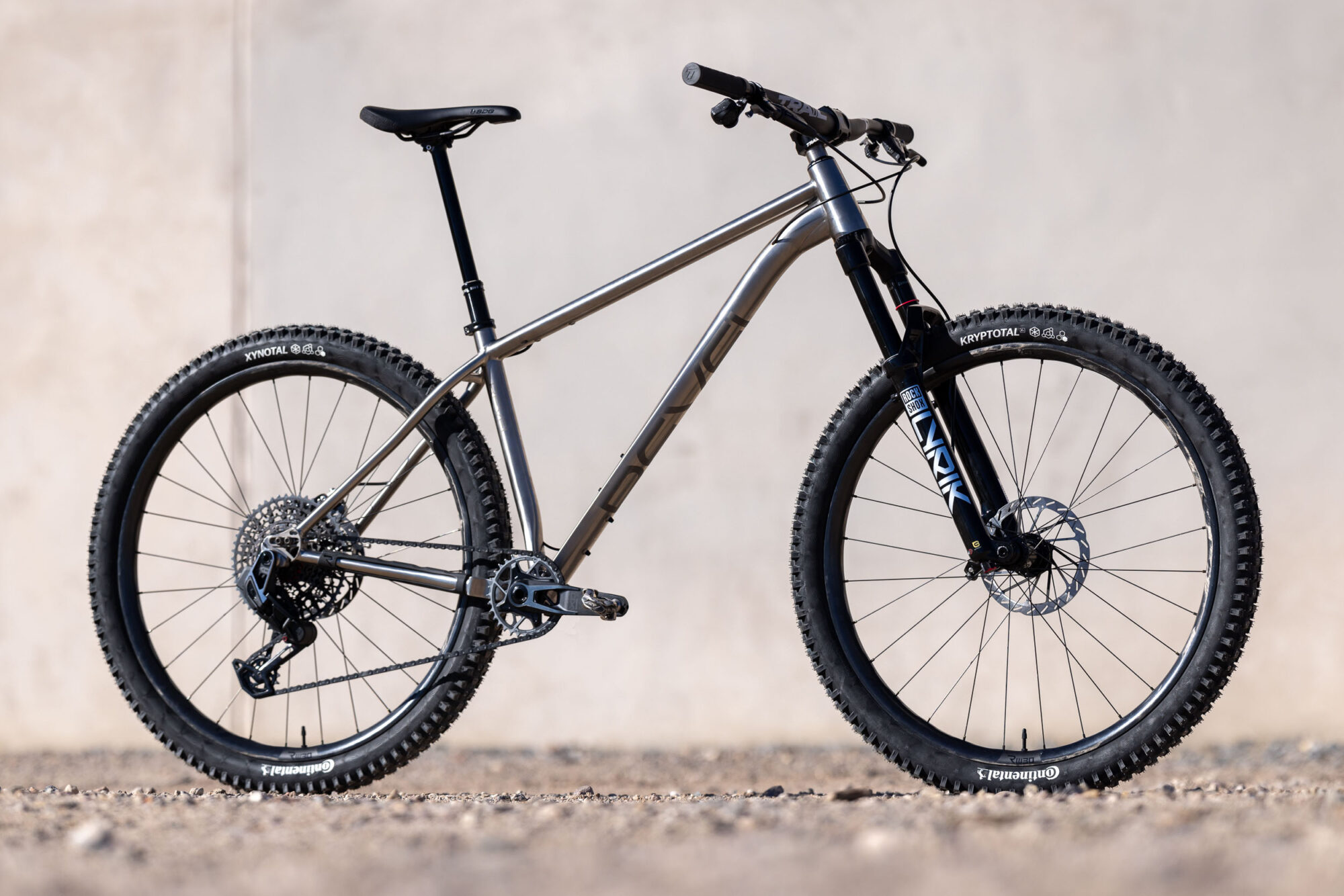
In 2020, Why Founder Adam Miller launched a sister company, Revel Bikes. Last year, the two joined forces. The merger brought Revel’s lineup of carbon full-suspension mountain bikes and Why’s love for titanium together under one brand—they were already operating under the same roof. Although it went relatively unnoticed, this also marked the end of the S7. I remember thinking fondly about my five-year relationship with the S7 and wondering if Revel had plans to replace it. I’ve logged thousands of miles on it and still consider it one of the most playful and versatile hardtails I’ve ridden. However, it would be a stretch to say it has the same swagger as the latest hardtails that are on the market. In fact, since testing bikes like the Chromag Surface Voyager and Esker Japhy, the S7 feels a little outdated on gnarlier terrain.
According to Matt Boughton in Revel product development, the Tirade is a good case of the motto they live by: “Designing the bikes we want to ride.” He explained that their hardtail lineup is interesting because two of the four are niche products: the Big Iron fat bike and the Wayward bikepacking bike. The El Jefe is more cross-country focused with its 120mm fork, so they thought it was time to introduce a hardtail with more trail-bike-inspired geometry and a longer travel fork. When I asked Matt about the reasoning behind its name, he explained that the “Ti” in Tirade was a nod to its titanium construction and Why Cycles’ beginnings. Matt also mentioned that since they discontinued the S7, they planned to replace it with something similar but more aligned with current trends. Matt explained, “The Tirade is a hardtail capable of much more aggressive riding than our El Jefe. The name feels like it matches the attitude of the bike well.”
Having spent thousands of hours riding the Why S7 and quickly racking up hundreds of miles aboard the Tirade over the last month, the Tirade seems like the logical next step considering where the S7 left off.
Revel Tirade: A Closer Look
The Why S7 and Revel Tirade are different beasts but have some noteworthy similarities. They’re both made from high-grade 3/2.5 titanium and have sliding dropouts, and clearance for big tires. Just like the Revel Wayward and El Jefe, the S7 and Tirade are built from cold-formed tubing that Revel designed to fine-tune the frame’s ride quality. It’s easy to spot this manufacturing process by looking at the downtube and seat tube; both taper from a circular tube down to a rectangular shape at the bottom bracket. The idea is to provide compliance closer to the rider and stiffness down low. The headtube, bottom bracket shell, and dropouts require greater strength and rigidity and are CNC-machined from blocks of 6/4 titanium. Unlike their other titanium bikes, the Tirade uses a thicker, double-butted downtube and top tube and a gusset at the head tube/downtube junction for increased strength and stiffness. There’s also a small plate between the seat stays at the bottom bracket. These are telltale signs that Revel designed the Tirade for more heavy-hitting, all-mountain style riding.
Aside from some big geometry shifts, which we’ll get to later, the Tirade separates itself from the S7 with the introduction of SRAM UDH-compatible sliding dropouts, which provide 17mm of chainstay length adjustment and a shortest setting of 420mm. Revel included a slick little measurement gradient on the top of the rear dropouts, so you quickly know what your chainstay length is. Like El Jefe, the Tirade doesn’t have rear rack mounts and only has a single bottle cage mount inside the main triangle. There’s another set of bosses under the top tube for accessories or a bolt-on frame bag and standard (not triple-pack) bottle mounts under the downtube.
Other frame specs include boost hub spacing and a welded plate chainstay yoke for a short rear end while leaving plenty of space for 29 x 2.6″ tires with room for mud and debris, even in the shortest position. It has the same internal cable routing found on all of their titanium bikes, internal dropper post routing, a custom rubber chainstay protector, and relatively subdued sandblasted graphics.
First Ride Impressions and Geometry
The Revel Tirade is undoubtedly a progressive hardtail. On the surface, you might think its 64.7° (un-sagged; 66.2° sagged) headtube angle is slack compared to the bikes we typically review–the Pipedream Sirius S6 and Transition TransAm being the exceptions. It also has a reasonably low 59mm bottom bracket drop (un-sagged) that requires a little more focus on crank rotation than other bikes, but it keeps the overall center of gravity low and tires planted to the dirt.
All this came to light a few days prior to a week-long bikepacking trip in Southern Arizona. The good folks at Transit Cycles in Tucson, the local Revel dealer, got the bike ready for me to ride and I was riding around Tucson Mountain Park just a few hours later. This was my first time on the Tirade and my only shakedown ride before pedaling hundreds of miles along the Arizona Trail and rough gravel roads south of the city.
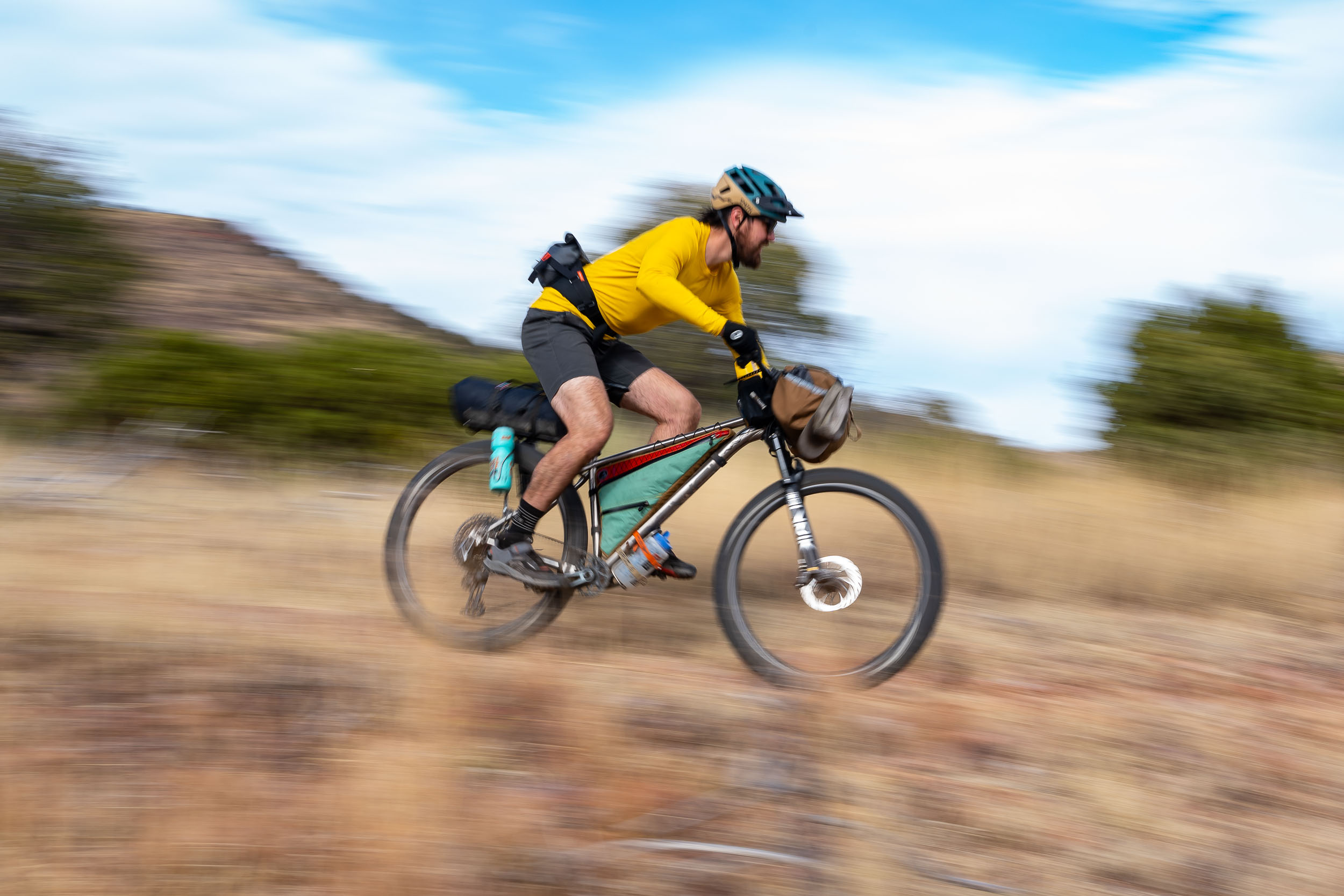
I generally try to avoid taking untested bikes on trips, but thankfully, much of what I expected from the Tirade was confirmed once on the trail. It’s a long bike thanks to its slack front end, extended wheelbase, and 641mm top tube. Looking at sagged geo numbers shows it’s not the slackest hardtail I’ve reviewed, but it’s progressive enough that it still required extra focus while climbing and navigating technical, slow turns. However, it was a different story when I had some momentum behind it. It didn’t take long to confirm that the Tirade shines when pointed downhill. It wants to move briskly.
| Size | S | M | L | XL | XXL |
|---|---|---|---|---|---|
| SEAT TUBE C-T | 370 | 410 | 440 | 470 | 510 |
| BB DROP | 59 | 59 | 59 | 59 | 59 |
| REAR CENTER | 420-437 | 420-437 | 420-437 | 420-437 | 420-437 |
| TOP TUBE EFFECTIVE | 603 | 627 | 641 | 671 | 698 |
| STACK | 626 | 640 | 650 | 660 | 676 |
| REACH | 427 | 446 | 467 | 492 | 522 |
| Standover (29 x 2.4″) | 717 | 720 | 728 | 742 | 760 |
| TRAIL (29 X 2.4″) | 131 | 131 | 131 | 131 | 131 |
| FORK OFFSET | 44 | 44 | 44 | 44 | 44 |
| HEAD ANGLE | 64.7° (66.2°) | 64.7° (66.2°) | 64.7° (66.2°) | 64.7° (66.2°) | 64.7° (66.2°) |
| HEAD TUBE LENGTH | 95 | 110 | 122 | 132 | 149 |
| SEAT TUBE ANGLE | 74.5° (76°) | 74.5° (76°) | 74.5° (76°) | 74.5° (76°) | 74.5° (76°) |
| WHEELBASE | 1163 | 1190 | 1215 | 1240 | 1280 |
| RIDER HEIGHT GUIDE cm | 5’1″-5’6″ | 5’5″-5’10” | 5’9″-6’1″ | 6’0″-6’4″ | 6’3″-6’8″ |
*Note that the above geo chart Revel supplied is based on a 140mm fork at 0% sag. Re-calculating these numbers with 25% sag shows a ~1.5° steeper seat tube angle and head tube angle. Adjusted numbers are shown in brackets. Not so progressive after all?
I originally thought the 74.5° seat tube angle was slack for a bike in this category, but after re-calculating for sag, it actually sits closer to 76°, which is fairly steep, although not as steep as some, like the Transition TransAm. I have a feeling the long top tube and my lankier-than-average legs helped offset the seat tube angle. On the trail, this translated to more weight shifting back off the front wheel, making it even more crucial to counteract this while riding. I found that if I got lazy, particularly on steep climbs, the front wheel lifted or slid out.
My experience was wildly different on fast descents. With the cranks parallel to the ground, the plush Rockshox fork wide open, and gravity doing its thing, the Tirade charges confidently through anything in its path, earning its namesake on the downs. At speed, the familiar springy playfulness I love about the Why S7 revealed itself. I carved into berms, leaned the bike toward the ground, and generally had a blast anywhere pedaling wasn’t necessary.
Ti Hardtails Compared
| Bike Model | Headtube/Seattube Angle | BB Drop (mm) | Reach / Stack (mm) | Chainstay Length (mm) |
|---|---|---|---|---|
| Revel Tirade (L) | 66.2°/76° (sagged) | 59 (un-sagged) | 467/650 | 420-437 |
| Knolly Tyaughton Ti (L) | 64.5°/75° | 49 | 495/640 | 427 |
| Binary Maniak Ti (L) | 65°/76.5° | 58 | 474/648 | 425-440 |
| Pipedream Sirius S6 Ti (L) | 65°/77.5° | 64 | 485/596 | 425-441 |
| Esker Japhy Ti (L) | 66°/76° | 65 | 470/614 | 430 |
| Chromag Rootdown Ti (L) | 64°/76° | 50.8 | 487/648 | 420 |
A comparison against other similar hardtails shows a slightly slacker seat tube angle, a generously slack head tube angle, reasonably short adjustable chainstays, and a relatively low bottom bracket. Remember that Revel’s geo numbers are based on a 140mm fork at 0% sag, and re-calculating the geometry based on 25% sag shows a 66.2° head tube angle and 76° seat tube angle, which is roughly 1.5° steeper than the provided numbers. With this in mind, the Tirade’s real-world geometry starts to look surprisingly similar to the Esker Japhy, another bike I’ve ridden extensively. Knowing this, I’d say the Tirade is a fantastic candidate for a 150mm or even a 160mm travel fork for riders looking to stay true to Revel’s numbers. I asked Revel why they provide un-sagged geo numbers, and they explained that they’re changing all of their geometry charts because they see it as the standard for full-suspension bikes. The idea is that this will make it easier to compare their full-suspension and hardtail platforms, but as we see it, this makes it trickier to compare against other hardtails that use sagged geo numbers—which is most bike companies; it makes much more sense considering that hardtails hinge at the rear axle, which produces a variable geometry based on the compression of the fork, whereas the angles of full-sussers and rigid bikes largely remain constant.
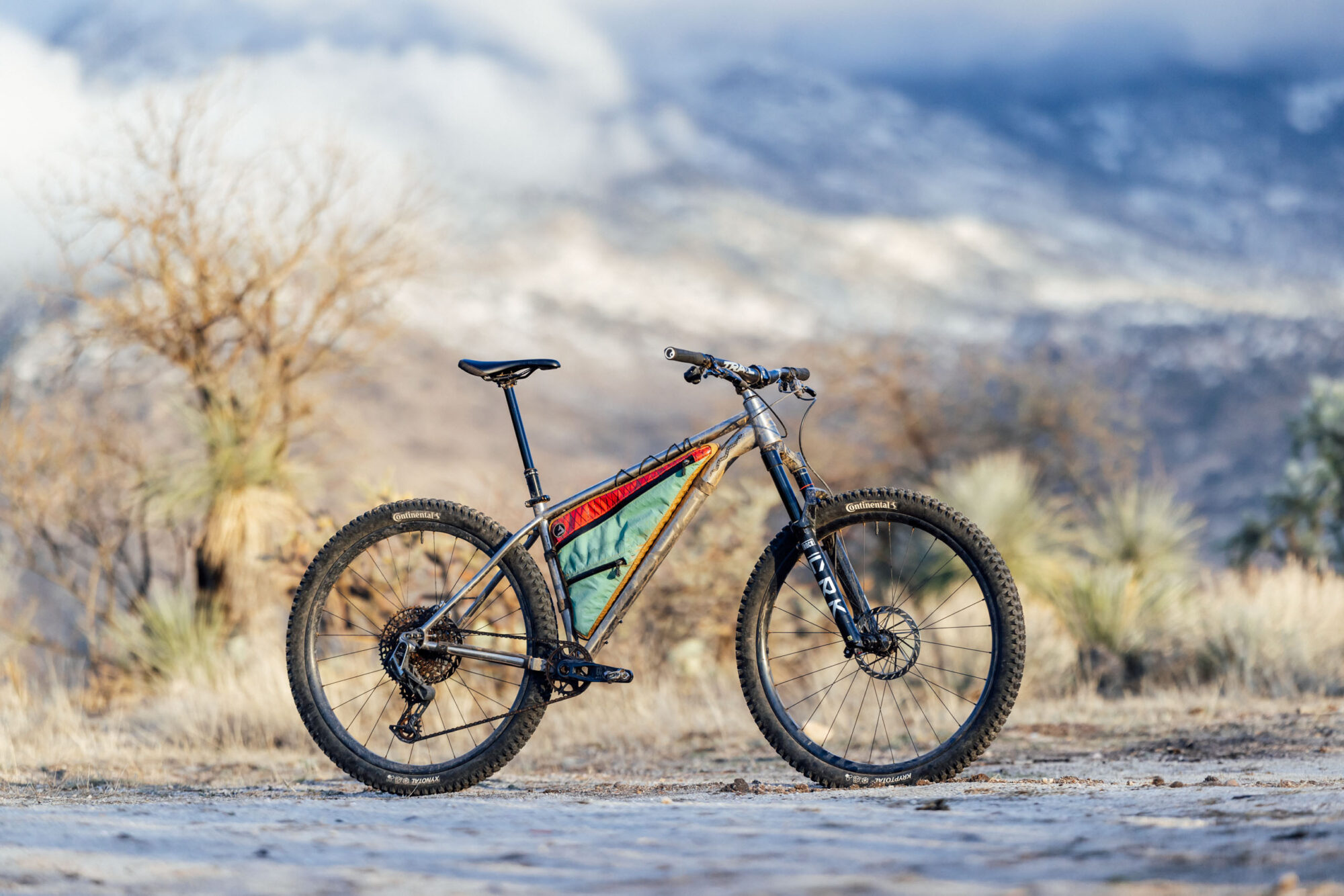
Beyond having to remind myself to shift my weight over the front of the bike, I didn’t mind the slightly slacker seat tube angle. As the Tirade makes its way through its 140mm of travel, the seat tube effectively steepens, and this can sometimes feel a little harsh, like getting bucked toward the front of the bike with super steep seat tubes and long-travel forks. The Tirade, on the other hand, has a pleasantly consistent feel. At 6’1″ with a 33″ inseam, I initially hoped to test an extra-large frame, but I think I prefer the slightly shorter fit and ample standover on the large. In some photos, you can see that I could have squeezed in a longer travel post, which would only improve my bike-body separation. Considering my bike came equipped with a 213mm travel post, I believe the 240mm travel OneUp dropper would be the only potential upgrade. With that in mind, I’d likely choose the extra-large frame next time.
Bikepacking on the Revel Tirade
Shortly after my first unloaded ride, I was packing several liters of water, a prototype rear rack, and a selection of bags onto the Tirade. Winter bikepacking in Southern Arizona requires a relatively lengthy gear list, so my setup wasn’t light. I was nervous about dragging a heavy setup down the Arizona Trail. Still, I was optimistic about how the Tirade would handle the extra weight of a bikepacking setup.
I did my best to spread the weight evenly across the bike, hoping to maintain the downhill prowess I experienced on that first ride while improving its climbing capabilities. As expected, extra weight on the front end improved front-wheel traction, even after six hours on the bike. I wasn’t clearing every tight switchback climb I encountered as we pedaled into the night on the Arizona Trail, but I wasn’t a complete mess either. Long bikes like the Tirade keep you from getting lazy. It was amazing what I could ride with a full bikepacking setup, but I began to struggle on awkward terrain when I was losing steam. For anyone from a more cross-country background, the Tirade will likely have a more extended “getting used to” period than you’re used to.
The Tirade’s extra gussets and thicker tubing meant there was no unwanted flex despite the extra weight of a bikepacking setup. This translated to a fighting chance to navigate technical, loose climbs and sneak through tight, pedal-grazing boulders. Every pedal stroke pushed the bike further along the trail. While bikepacking, this meant I was more likely to attempt tricky moves that I might typically get off and walk up. It provided a sense of confidence that was impossible to shake, even after hours of riding or bombing down white-knuckle descents.
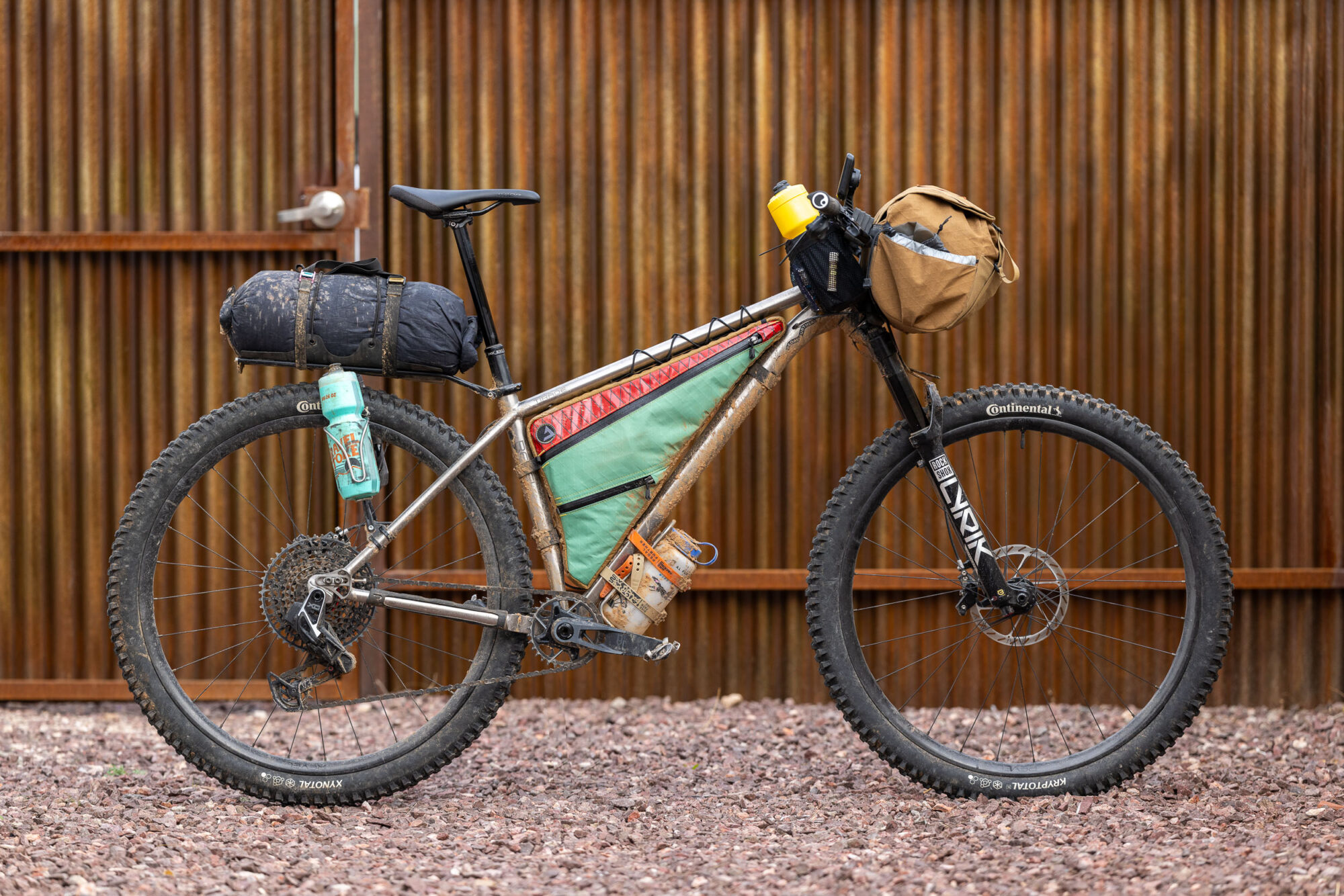
The Ti in Tirade
Part of me hoped the Tirade would ride like the S7, which has a downright addictive lightweight and springy feel. While there are hints of these characteristics, mostly when charging downhill at full speed, the Tirade isn’t quite as maneuverable at low speeds. I attribute this to its longer silhouette and slacker geometry. Compared to most of the hardtails I’ve recently ridden, including the Mason Raw and my Why S7, the Tirade felt a tad sluggish picking its way through slow, awkward terrain. That’s not to say it wasn’t comfortable. Even in the slow stuff, it had that magical titanium feel and vibration absorption, but it was clear Revel designed the Tirade with descending in mind. I ran this by Adam Miller, and he confirmed that it’s stiffer and heavier than their other titanium hardtails because it’s designed around a longer-travel fork and more aggressive riding. He also said the weight difference between the Tirade and El Jefe is minimal, and it’s not something they get hung up on, but ride quality, geometry, and durability receive special attention.
It’s hard to discern between frame feel and the effect of chunky 2.4″ tires and a high-end 140mm fork, but considering the amount of time I’ve spent pedaling the Tirade, I’d say the cold-formed titanium tubes achieve what Revel set out to accomplish. All it takes is some G-force-inducing riding to wake the Tirade up. I found the S7’s responsiveness in the Tirade when pushing into the enduro end of my riding limits. Popping off rocks and small ledges became mandatory, not voluntary, and pushing the bottom bracket into berms and natural banks along the Arizona Trail and others became an instinctive response. I didn’t have a chance to test the Tirade with 2.6″ tires, but I imagine they would further stretch its comfort and overall capability.
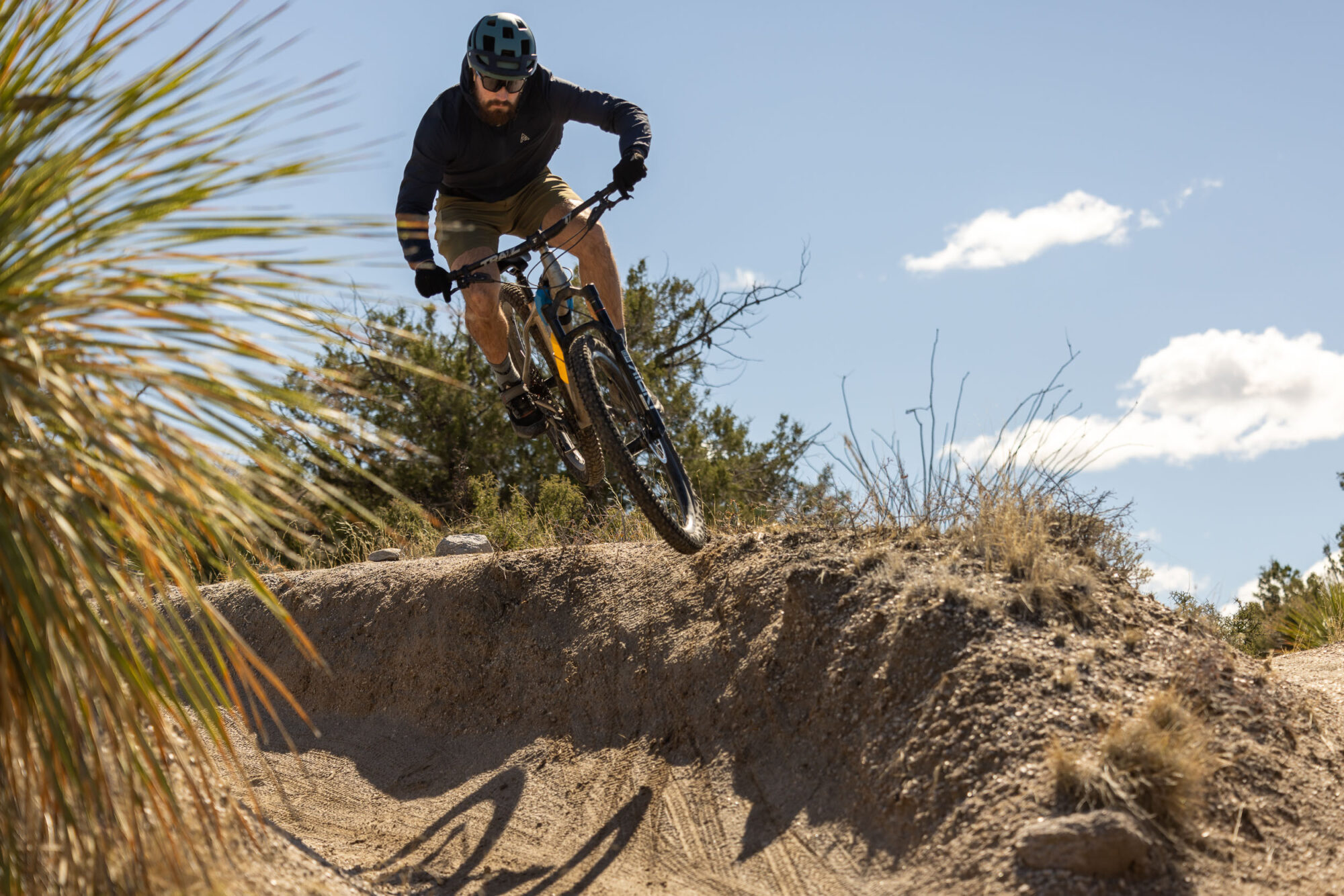
Surprisingly, the characteristics that make the Tirade most at home on fast, steep terrain also translate to a comfortable perch on gravel roads and doubletrack. About half of our week-long bikepacking trip out of Tucson involved such terrain, and I found the Tirade to move swiftly and efficiently. The low bottom bracket and long stance surely played a role in this, as did running the rear axle in the middle of the sliding dropout. Efficiently pedaling a Lyric-equipped trail bike down gravel roads served as a real-world reminder that hardtail mountain bikes—even those that seem too slack to bikepack on—are incredibly versatile.
Build Kit + Purchasing Options
The Tirade build Revel sent me leaves little to be desired. It had top-of-the-line everything, which undoubtedly played a role in my experience on the bike. This was my first time using SRAM’s Transmission. Though I’m slightly nervous about relying on electronics and Bluetooth connections for multi-day rides, I now understand the hype. The new Pod Shifter is considerably more ergonomic than the previous paddle-style AXS shifter, and the buttons have a more tangible click that never results in accidental shifts—a known problem of the previous AXS shifter. Like AXS, the T-Type derailleur has a safety feature that allows it to shift inboard automatically after an impact to protect itself. I unintentionally tested this feature early on in our bikepacking trip while navigating super tight rocks. The derailleur came in contact with a rock, let out a chirp, signifying a shift, and then returned to its original position. I wondered what a standard derailleur hanger might have done.
The other standout component was the 140mm travel RockShox Lyric Ultimate fork. This was the first time using a fork equipped with RockShox’s ButterCups and Charger 3 damper. ButterCups are little gold-packaged rubber pucks that live at the end of the damper and air spring shafts and fit into the lower fork leg. They are designed to dampen high-frequency vibrations before they hit your hands and arms and cause fatigue on long days of riding. RockShox claims they eliminate trail chatter by an average of 20%. I had no hand or upper body discomfort during my entire test period, and the fork had a consistent feel, whether navigating smaller features or blasting through melon-sized rock gardens. Still, many variables influence how much vibration you feel while riding. Tire pressure, rim material, handlebar material and shape, and the frame all play a role. I ran my tire pressure a touch higher than usual to accommodate the weight of a bikepacking setup and avoid pinching the tire on my rim against sharp Arizona rocks.

The Continental Kryptotal and Xynotal proved exceptionally durable considering how many miles I logged on jagged, tire-eating trails. They bite well, which is important when leaning a bike like the Tirade into loose, hardpacked corners. The Bike Yoke dropper had some squish at first, but I was able to use the reset valve to remedy that, and it hasn’t happened since. The ultra-smooth Revel-branded Wolf Tooth dropper lever was also a nice touch.
SRAM X0 Build Kit
- FRAME: Revel Tirade, Size Large
- FORK: RockShox Lyric Ultimate 140mm
- CRANKSET: SRAM X0 Eagle T-Type, 32T
- SHIFTER: SRAM AXS Eagle Pod
- CASSETTE: SRAM X0 Eagle Transmission, 10-52T
- DERAILLEUR: SRAM X0 Eagle Transmission
- CHAIN: SRAM X0 Eagle Transmission Flattop Chain
- BOTTOM BRACKET: SRAM DUB BSA, 73mm Threaded
- RIMS: Revel RW30
- FRONT HUB: Industry Nine Hydra 15x110mm
- REAR HUB: Industry Nine Hydra, 12x148mm
- FRONT TIRE: Continental Kryptotal 29×2.4″
- REAR TIRE: Continental Xynotal 29×2.4″
- BRAKES: SRAM CODE RSC
- ROTORS: SRAM HS2, 180mm
- HANDLEBAR: Trail One Crockett Carbon Bar
- STEM: Trail One Viking Stem, 40mm
- SEATPOST: Bike Yoke Revive 213mm
- DROPPER LEVER: Wolf Tooth ReMote
- SADDLE: SDG
- HEADSET: Cane Creek
Revel is offering the Tirade as a frame-only option and in five complete builds. The frame will set you back $2,499 USD, the same price as an El Jefe or Wayward frame. The complete builds start at $5,199 and top out at $9,599. While these prices aren’t in reach for most, they’re comparable to (or less expensive than) other Taiwan-made titanium hardtails. However, I don’t see the Tirade as an introductory or even novice-level bike, as it begs to be ridden on challenging, steep terrain. If you’re the type of rider considering a rowdy mid-travel titanium hardtail, you’ve likely already accepted how much cash you’ll have to fork out. Choosing the Tirade over other options will ultimately come down to its geometry, burly construction, modern specs, or other thoughtful details like the chainstay quote, chainstay protector, clean cable routing, and sliding dropouts.
Revel Tirade Build Options
- Frame-Only: $2,499
- SRAM GX EAGLE: $5,199
- SRAM GX TRANSMISSION: $5,999
- SHIMANO XT : $5,499
- SRAM X0 TRANSMISSION: $6,999
- SRAM XX TRANSMISSION: $9,599
Pros
- Fills the gap between Revel’s hardtail and full-suspension lineup
- Thoughtful details like the sliding dropout measurement gradient, custom chainstay protector, subtle branding, and clean cable routing
- Mounts under the downtube and top tube add versatility
- Geometry shines on the descents but isn’t too aggressive for back-to-back days of pedaling
- High-end titanium construction and near-perfect blend of suppleness, rigidity, and responsiveness
- Clearance for 29 x 2.6” tires, even in the shortest dropout position
Cons
- Un-sagged geo chart is misleading
- No rack mounts, a single standard bottle cage mount, and no triple-pack mounts under the downtube
- Low bottom bracket might not be ideal if you have issues with pedal strikes (running 2.6″ tires would help)
- Short seat tube means less frame bag space, but also means long dropper posts
- Model/Size Tested: Revel Tirade/Large
- Actual Weight: TBD
- Place of Manufacture: Taiwan
- Price: $6,999 USD
- Manufacturer’s Details: RevelBikes.com
Wrap Up
It takes a certain amount of experience and bike-handling skills to get the most out of bikes in this genre, but in reality, to say they don’t make sense for bikepacking or big long mixed-surface rides would be a massive miss—even if the Tirade’s sagged head tube angle is closer to 66.2°. If all-mountain or even enduro-esque riding are up your alley, a slack hardtail mountain bike gives you a fighting chance of bikepacking in that type of terrain. Pair that with a well-designed titanium frame optimized for downhill efficiency and comfort, and the Revel Tirade starts looking surprisingly versatile.
While I’m confident that the Tirade can double as a daily driver trail bike and shredpacking rig, it’s not without its quirks. I wish it had rack mounts and a three-pack under the downtube, and its beefy frame (and resulting build) isn’t as lightweight or supple as more svelte titanium hardtails. Those running 29 x 2.4″ tires might also see an increase in pedal strikes, as I did, but 2.6″ tires and taking some time to get used to the low bottom bracket will help. Folks who have spent time on mid/long-travel trail bikes will be fine with hammering down steep descents and pushing the Tirade’s limits, even if they aren’t reached. Overall, the Tirade feels like a good case for a modern titanium hardtail, and Revel did a solid job of refining every little detail for a well-executed complete package. If long days and steep descents are in your future, the Tirade could be for you.

Do you enjoy our in-depth reviews, route guides, and stories? We’re a small, independent publication dedicated to keeping our content free for everyone, but we need your support. To keep articles like this one coming (and not behind a firewall), please consider becoming a member of our Bikepacking Collective. By joining, you’ll receive The Bikepacking Journal in the mail twice a year, industry discounts, and many other great benefits. Learn more here.
Further Reading
Make sure to dig into these related articles for more info...
Please keep the conversation civil, constructive, and inclusive, or your comment will be removed.






